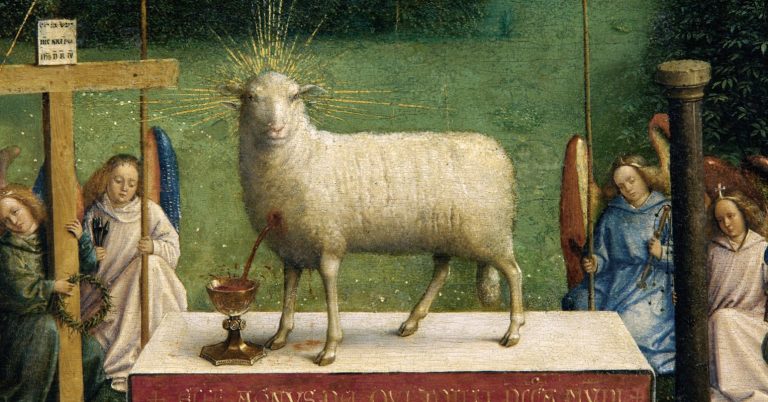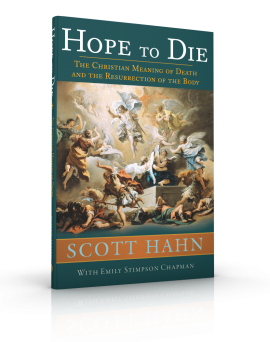By Scott Hahn
Dr. Scott Hahn is the best-selling author of over forty books, including Hope to Die: The Christian Meaning of Death and the Resurrection of the Body. He is the founder and president of the St. Paul Center and holds the Fr. Michael Scanlan Chair of Biblical Theology and the New Evangelization at Franciscan University.

Well before he walked up the steep road to Calvary, Jesus told his listeners how our resurrection would take place: “I am the living bread which came down from heaven; if any one eats of this bread, he will live for ever” (John 6:51).
And what is this bread? Jesus tells us in the very same line: “The bread which I shall give for the life of the world is my flesh” (John 6:51).
Not surprisingly, his Jewish listeners find this plan for resurrection decidedly unkosher. “How can this man give us his flesh to eat?” they ask (John 6:52).
So, Jesus gets even more specific:
Truly, truly, I say to you, unless you eat the flesh of the Son of man and drink his blood, you have no life in you; he who eats my flesh and drinks my blood has eternal life, and I will raise him up at the last day. For my flesh is food indeed, and my blood is drink indeed. He who eats my flesh and drinks my blood abides in me, and I in him. (John 6:53–56)
Later, on Holy Thursday, in the Upper Room, he shows us how this is possible, holding up first the bread and then the cup, saying, “This is my body . . . This is the cup of my blood,” and commanding the Twelve to “do this in memory of me.” In the original Greek of Luke’s Gospel, the word we translate as “memory” is anamnesis, which means so much more than simply “remembering.” It suggests a way of recalling past events that effectively makes the past present. In other words, you’re not repeating the action of the past; you’re entering into that very same action.
So, when Jesus tells the Apostles to “do this in memory of me,” he is commanding them to offer in time what he would offer the next day on Calvary and offer eternally in heaven. They’re not repeating the sacrifice. They can’t. You can’t repeat what never ends. They’re making present Jesus Christ’s own perpetual offering of himself.
They’re also enabling us to participate in the New Passover Sacrifice.
In the Eucharist, we consume the Lamb of God as the Israelites consumed the sacrificial lamb. That Lamb is the resurrected Christ. At every Mass, we consume Jesus’s resurrected, glorified body under the appearance of bread and wine. We eat the flesh and drink the blood of the God who became man, died, and rose again. The body that we eat is the same body that hung on the cross, lay in the tomb, and then rose from the dead. That body is also the same body that passed through walls, that could be in Emmaus one minute and Jerusalem the next, and then ascended into heaven to sit at the right hand of the Father.
God didn’t raise Jesus from the dead, though, and then welcome him back into heaven on Ascension Thursday in order to keep him tucked away behind some heavenly throne, safe from all the evil mortal men can do. Nor did Jesus ascend into heaven to protect himself or hide from the world in his Father’s sanctuary. If anything, Jesus’s Ascension makes him the sanctuary. It makes him the place of refuge for all who believe in him. It also makes him the eternal high priest, who can forever offer himself, forever give himself, forever communicate himself to us.
As our high priest, Jesus is now always offering himself. And in the Mass, as members of his body, adopted into the family of God through Baptism, we are always receiving him. That reception makes possible what Jesus long ago promised: that whoever ate his flesh and drank his blood would not perish but have eternal life. In Holy Communion, he enters into our mortal bodies so that we, in turn, can enter into his immortal, glorified body.
When we eat a hamburger or pizza or an apple, that hamburger or pizza or apple becomes part of us. We assimilate it into our bodies. But when we consume the Body and Blood of Jesus in Holy Communion, the exact opposite happens. Instead of us assimilating Jesus into our bodies, he assimilates us into his body. He doesn’t become part of our body. We become part of his body.
It is through this mysterious exchange of grace that the Eucharist becomes the instrumental cause of our resurrection. It works in our souls as both food and medicine, feeding us with God’s life, healing our souls of the effects of venial sin, and making us, day by day, into saints. It is the Eucharist that nourishes our souls, strengthens our commitment to living lives of grace, and unites us to our fellow believers, forming us corporately into the Body of Christ. Lastly, it is the Eucharist that imbues our mortal bodies with the capacity to be divinized and glorified and resurrected in the Body of Christ. As the Catechism puts it, the Eucharist is “the seed of eternal life and the power of resurrection” (CCC 1524).
This is why almost every single appearance of the resurrected Christ in Scripture happens in the context of a meal, and when the day is named, on a Sunday. These appearances—on the road to Emmaus, in the Upper Room, on the beach—all have Eucharistic overtones. Jesus breaks bread with his Apostles and feeds his Apostles, and as he does, he helps us understand that the Resurrection renders his body into something that is now distributable, communicable, and edible. His body has been glorified and his humanity deified, and as it enters into us, it creates the capacity within us to be glorified and deified too, to be resurrected on the last day.
You Might Also Like
In Hope to Die: The Christian Meaning of Death and the Resurrection of the Body, Scott Hahn explores the significance of death and burial from a Catholic perspective. The promise of the bodily resurrection brings into focus the need for the dignified care of our bodies at the hour of death. Unpacking both Scripture and Catholic teaching, Hope to Die reminds us that we are destined for glorification on the last day.
